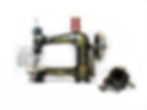The Art of Collecting Antique Sewing Machines: A Heritage to Preserve
- Elsa lambinet
- Sep 14, 2024
- 2 min read

The Art of Collecting Antique Sewing Machines: A Heritage to Preserve
Antique sewing machines are much more than simple tools of the past. They embody a true industrial and artistic heritage that has shaped the history of fashion and sewing. For enthusiasts and collectors, each piece tells a unique story, filled with craftsmanship and technical innovation.
Why Collect Antique Sewing Machines?
Collecting antique sewing machines means diving into a fascinating world where technology and craftsmanship intersect. These machines, often made of cast iron with exquisite decorative details, represent a time when every object was built to last. Iconic models from brands like Singer, Pfaff, and Bernina are highly sought after by collectors for their durability and timeless design.
Additionally, these vintage machines reflect the evolution of society and textile production, from the industrial revolution to the present day. Each model bears the marks of its era, whether in mechanical innovations or artistic styles of the time, such as Art Deco or Rococo.
How to Identify an Antique Sewing Machine?
Identifying an antique sewing machine can seem complex, but certain details can reveal its origins.
The Serial Number: Almost all vintage sewing machines have a serial number that helps determine the date of manufacture. These numbers can be cross-referenced with specialized online databases.
The Brand and Model: Some brands, like Singer, produced specific models that became iconic. For example, the Singer 15k is famous for its oscillating arm and elegant flywheel.
Style and Decoration: Many machines are richly adorned with gold motifs or engravings. These decorations can reveal the manufacturing period, often influenced by the artistic trends of the time.
Maintaining an Antique Sewing Machine
If you are fortunate enough to own an antique sewing machine, it is essential to maintain it properly to preserve its condition. Here are a few tips:
Cleaning: Use a soft cloth to remove dust, and apply a suitable lubricant to protect the mechanical parts.
Minor Restorations: If some parts are damaged or rusty, specialized products can help restore their shine without harming the original materials.
Spare Parts: Finding parts for older models can be challenging, but specialists and collectors can guide you to the right suppliers.
Where to Find Antique Sewing Machines?
If you are an enthusiast or collector looking for antique sewing machines, several options are available:
Flea Markets and Antiques Fairs: These are prime locations to find vintage sewing machines, often at very reasonable prices.
Auctions: Some rare machines are sold at auctions and can fetch significant sums, especially if they are in excellent condition.
Specialized Online Stores: Today, specialized websites offer restored or repairable machines, allowing collectors to discover rare models.
Conclusion
Antique sewing machines are much more than simple sewing tools. They are witnesses to a rich past of innovation and creativity. For collectors, each model holds immense historical value, and preserving these objects is essential to keeping the history of sewing alive. Whether you’re a collector or a casual enthusiast, the world of antique sewing machines offers a wealth of heritage and craftsmanship.

